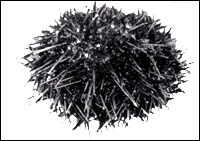
A team of Weizmann Institute and Brookhaven National Laboratory chemists has discovered that the suprisingly strong flexible spines of sea urchins are made of a most unusual composite material. This research, published recently in Science, has given rise to novel concepts in material science that may eventually lead to the development of tougher, lightweight consumer items.
While it has been long known that an urchin spine is composed of a single crystal of calcite, the most common calcium-containing mineral, no one could explain why these crystals are so much more resistant to fracture than are calcite crystals from geologic formations or those grown in the laboratory. Prof. Lia Addadi, Prof. Stephen Weiner and Dr. Amir Berman of the Institute's Department of Structural Biology have now shown that this phenomenon is due, in part, to the entrapment of proteins within the crystal. In follow-up studies of these novel single-crystal composites by synchrotron X-ray radiation, this team -- together with Drs. Ake Kvick and Mitch Nelson of the Brookhaven National Laboratory in New York and Prof. Leslie Leiserowitz of the Institute's Department of Materials and Interfaces -- discovered how the entrapped proteins act to prevent cracks from spreading through urchin calcite. They found that laboratory-grown calcite crystals obtained from solutions containing proteins extracted from urchin spines had rodlike protein molecules integrated into planes oblique to the crystal cleavage planes, which would interfere with fracture propagation.
Their observations might eventually lead to the development of new single crystal-polymer composites that could be used to make less brittle materials. Continuing stages of this research are being supported by the United States-Israel Binational Science Foundation.

